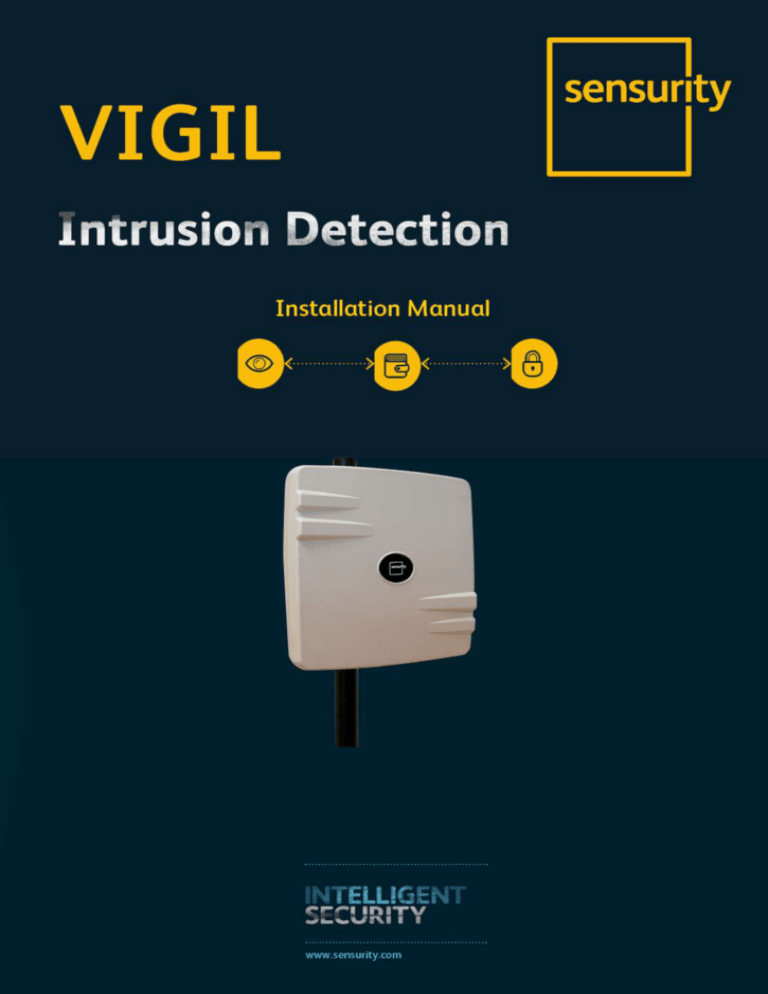Installation Manual
advertisement

1 REVISION HISTORY ............................................................................................................................ 4 2 ABBREVIATIONS ................................................................................................................................. 5 3 OVERVIEW ........................................................................................................................................... 6 4 5 6 7 3.1 INTRODUCTION .............................................................................................................................................................. 6 3.2 THEORY OF OPERATION................................................................................................................................................ 6 3.3 SPECIFICATION ............................................................................................................................................................... 6 3.4 FEATURES AND BENEFITS .............................................................................................................................................. 7 DETECTION CHARACTERISTICS ........................................................................................................ 8 4.1 DETECTION REQUIREMENTS ......................................................................................................................................... 8 4.2 TYPICAL DETECTION PATTERNS ................................................................................................................................... 9 4.2.1 Microwave .............................................................................................................................................................. 9 4.2.2 Deadzone ................................................................................................................................................................ 9 SYSTEM COMPONENTS ................................................................................................................... 11 5.1 HARDWARE COMPONENTS ........................................................................................................................................11 5.2 SOFTWARE COMPONENTS ..........................................................................................................................................11 SYSTEM DESIGN ................................................................................................................................ 12 6.1 SITE PLANNING ............................................................................................................................................................12 6.2 FOLIAGE MANAGEMENT .............................................................................................................................................12 6.3 UNEVEN TERRAIN ........................................................................................................................................................12 6.4 RAIN, STANDING WATER AND FROST .......................................................................................................................12 INSTALLATION PROCEDURE ........................................................................................................... 13 7.1 POLE MOUNTING ........................................................................................................................................................13 7.2 ALIGNMENT ..................................................................................................................................................................13 7.3 VIGIL WIRING .............................................................................................................................................................14 7.4 VIGIL CONFIGURATION..............................................................................................................................................15 7.4.1 Installing the VIGIL Configuration Utility ..................................................................................................15 7.4.2 Adding users to the OSDP Hub.....................................................................................................................15 7.4.3 Starting the VIGIL Configuration Utility ....................................................................................................16 7.4.4 Installing a VIGIL Device .................................................................................................................................17 7.4.5 Configuring a VIGIL Device ............................................................................................................................20 7.4.6 VIGIL Configuration Utility Tabs ..................................................................................................................24 Revision History 8 VERIFICATION AND TEST ................................................................................................................ 27 9 MAINTENANCE ................................................................................................................................. 29 Installation Manual 3 VIGIL Revision History 1 Revision History Date Version Signed Comments 05/08/2015 1 Maria Heneghan Document Created 20/10/2015 1.1 Maria Heneghan 3.4 Added Feature 7.4.4 Updated diagrams of Configuration Utility and description 7.4.5 Updated diagrams of configuration utility and altered text regarding device configuration. Added section on Algorithms Table 1: Revision History Installation Manual 4 VIGIL Abbreviations 2 Abbreviations CP Control Panel DSP Digital Signal Processing FSK Frequency Shift Keying OSDP Installation Manual Open Supervised Device Protocol PDs Peripheral Devices PIDS Perimeter Intrusion Detection System POE Power Of Ethernet RSSI Received Signal Strength Indicator RX Receiver SCS Secure Channel Session TX Transmitter 5 VIGIL Overview 3 Overview 3.1 Introduction VIGIL is a bistatic radar, Perimeter Intrusion Detection System (PIDS). The system is comprised of VIGIL Transmitter (TX) and VIGIL Receiver (RX) pairs. The VIGIL is a platform based system which operates at distances ranging from 3 – 200M. The VIGIL has Ethernet connectivity as standard (RS485 optional) for configuration and integration. Each VIGIL is pre-configured as a TX or RX unit. VIGIL brackets (part code VIGIL-BRK) are supplied with VIGIL units as standard. 3.2 Theory of Operation The VIGIL system consists of pairs of TX’s and RX’s. The system detects the presence of objects moving through the detection zone created by each TX / RX pair. On detection of an object an alarm is generated which can activate any of the following: 3.3 1. Relay Closure / Open – user configurable 2. Alarm notification via Ethernet (or RS485) Specification Parameter Value Frequency 5.785-5.815 GHz. Modulation Full-duplex bidirectional FSK Channels 30 + Range 3 – 200 m Probability of Detection 99% Temperature -40°C to 65°C. Humidity 0 – 95% Non – Condensing Power Requirements 12-48V / POE Current Consumption 450mA Housing IP67 rated Installation Manual 6 VIGIL Overview 3.4 Features and Benefits One software configurable relay Installation and Integration via Ethernet (or RS485) Self-calibrating, adaptable DSP using 3 distinct signal paths Software Adjustable Sensitivity 12 – 48V or POE powered Five distinct software activated alarm types: Environmental, Error, Tamper, Intruder and Power Three distinct algorithms suitable for varying environments with eight sensitivity levels for each. Installation Manual 7 VIGIL Detection Characteristics 4 4.1 Detection Characteristics Detection Requirements The VIGIL will detect any object with a mass > 35Kg moving through the detection zone created by each TX/RX pair. Figure 1 depicts a side view of the detection zone of the VIGIL. Figure 1: VIGIL Detection Zone side view The VIGIL has eight software configurable sensitivity settings which make the VIGIL suitable for installations in multiple environments and locations. The height and width of the detection zone varies due to software configurable sensitivity level assigned to the RX. The sensitivity level effect on the beam width is depicted in Figure 21. 1 Figure 2 is not to scale. The beamwidths for each sensitivity level are exaggerated in order to demonstrate the effect. The data is based on a 100M link. Installation Manual 8 VIGIL Detection Characteristics Figure 2: Sensitivity Effect on Beam Width - Ariel View 4.2 4.2.1 Typical Detection Patterns Microwave Microwave bistatic radar links have a detection zone which is ellipsoid in shape, i.e. the detection zone is widest at the middle of the link and narrowest at either side of the link. The width of the detection zone of the VIGIL is no greater than 5m. 4.2.2 Deadzone Traditional Microwave systems have a ‘dead zone’ within which intruder movement may remain undetected by the system, as the forward scattered multipath signals generated by the movement of the intruder may be at a level lower than that which may be discerned from noise at the receiver. The dead zone is located (i) on the ground directly below and in front of their transmit/receive antennas, (ii) above the transmit/receive antennas. The deadzone is covered by “crosshatching” the units as shown in Figure 3. Installation Manual 9 VIGIL Detection Characteristics Figure 3: Crosshatched pairs The deadzone length l in Figure 3 is < 2m with a VIGIL mounting height of 1.1m. Installation Manual 10 VIGIL System Components 5 System Components 5.1 Hardware Components The VIGIL TX and RX units are physically identical. However there are hardware differences and thus the modules are pre-configured as either a TX or RX unit. Each VIGIL unit consist of the following components: 1. Antenna 2. Motherboard 3. VIGIL Front Cover 4. VIGIL Rear Cover 5. Bracket 270mm x 270mm x 75mm Figure 4: VIGIL Hardware Components 5.2 Software Components Sensurity provides a VIGIL configuration utility in order for users to install and configure VIGIL units. The executable installs the following components: 1. VIGIL Configuration Utility - a UI for the user to configure a network of Peripheral Devises (PDs). 2. OSDP Hub - a communications application used to network a mixture of RS485 and TCP/IP PDs with a Control Panel application connected over TCP/IP. This application simply acts to relay data packets between the attached Control Panel and all PDs. Installation Manual 11 VIGIL System Design 6 System Design 6.1 Site Planning Ensuring the suitability of a site for installation of the VIGIL system is imperative. A site survey prior to install should be carried out to ensure that nodes are located in such a manner as to be most beneficial to the site. 6.2 Foliage Management It is recommended to keep foliage within the detection zone to a minimum. Foliage encroaching on the detection zone may result in false alarms due to movement caused by wind. It is not advised to have trees directly within the detection field as their movement due to wind may cause alarms. 6.3 Uneven Terrain The operation of a VIGIL link requires transmission of energy from the transmitter to the receiver it is therefore recommended that there is line of sight between the transmitter and receiver units. To ensure a clear line of sight between the units the ground must be flat across the detection zone. A slope is permissible however troughs or hills may shadow the beam and thus allow crawl spaces (dead zones) for an intruder. See Figure 5. The protected area can be made up of any surface such as tar, concrete, grass, tilled earth or gravel Figure 5: Uneven Terrain 6.4 Rain, Standing Water and Frost The VIGIL is unaffected by rain, frost and snow. Fast flowing water in the detection zone (such as streams etc.) may cause alarms and it is thus recommended that the detection zone be free from streams or large pools of water. Installation Manual 12 VIGIL Installation Procedure 7 7.1 Installation Procedure Pole Mounting The VIGIL should be mounted on a pole of diameter no less than 40mm. A mounting height of 1.1m is recommended. The mounting height given is relative to ground level, of the midpoint of each TX/RX enclosure. Figure 6: VIGIL Mounting 7.2 Alignment TX/RX enclosures for each link should be mounted at the same height and be facing each other with clear line of sight. The maximum offset of the devices should be no greater than 6° to ensure maximum operational capability. Installation Manual 13 VIGIL Installation Procedure Figure 7: VIGIL Mounting and Alignment 7.3 VIGIL Wiring The vigil comes with ethernet connectivity by standard, a DC input and one Relay output. The pin out for the DC connector and the Relay connector are in Table 1 and Table 2. PIN NUMBER 1 2 3 CONNECTION NO1 COM1 NC1 Table 1: Relay Connector PIN NUMBER 1 2 CONNECTION 12V 0V Table 2: DC Connector All connnectors are provided with each VIGIL unit. Installation Manual 14 VIGIL Installation Procedure 7.4 VIGIL Configuration 7.4.1 Installing the VIGIL Configuration Utility Download and install the latest version of the VIGIL control panel: VIGIL_cp-installer.exe Double click on the installer to start installation The Microsoft Visual C++ redistributable is required to run the configuration utility. If not already installed the VIGIL executable will install it. If the PC has the redistributable previously installed the dialog box in Figure 8 will appear. Click on close to continue with the configuration utility installation. Figure 8: Microsoft Visual C++ Redistributable Installed Dialog Box If the Microsoft Visual C++ redistributable has not been previously installed on the PC the dialog box in Figure 9 will appear. The user must agree to the license terms and conditions and install the redistributable in order to install the VIGIL Configuration Utility. Figure 9: Microsoft Visual C++ Redistributable Install Dialog Box 7.4.2 Adding users to the OSDP Hub The OSDP Hub allows multiple users to be supported in connections from a Control Panel (CP) on the Master TCP/IP port. Access to this port requires access using a username and password. The Secure Remote Password (SRP) protocol (a patent free IETF standard) is used to store username/password credentials on the OSDP Hub server machine and to perform a 2-way handshake initiated by the CP (client). The software installer will automatically configure the following default username and password: Username: admin Password: 1234 Installation Manual 15 VIGIL Installation Procedure 7.4.3 Starting the VIGIL Configuration Utility NOTE: When installing the VIGIL over IP the computer the VIGIL hub utility is running on should be set to static IP address 192.168.2.10. Run the utility Start -> All Programs -> Sensurity -> HALO Control Panel The user will be prompted for a password. This password is used to encrypt the OSDP master key stored in the osdp_map.xml. See Figure 10. If running the CP for the first time insert the default password 1234. Figure 10: Enter Password Prompt Following the login process the user will then be presented with the User Interface (UI) Status Page in Figure 11. To connect to a network, the user should select the Connect button in the top left corner of the UI. Figure 11: VIGIL Configuration Utility UI The user will then be prompted to enter the IP address and port of the OSDP Hub executable. The default IP address is localhost (i.e. 127.0.0.1) meaning that the OSDP Hub is running on the local machine. See Figure 12. If OSDP Hub is running on another computer the UI can connect to it using that Installation Manual 16 VIGIL Installation Procedure computer's IP address. The default port of 27043 should only be changed it the default master port on OSDP Hub has been changed. The username and password is required to authenticate the connection to the hub. The details should be inserted in the dialog box in Figure 12. If the user is logging in for the first time – the default username and password should be used. Username: admin Password: 1234 Figure 12: Connection Authentication 7.4.4 Installing a VIGIL Device If the device is connecting to the CP for the first time then it must be installed. To install the device click on File -> Install Device. See Figure 13. Figure 13: Install Device Installation Manual 17 VIGIL Installation Procedure If an uninstalled device is found the Install dialog box will be displayed – See Figure 142. Choose an OSDP address for the device (0-126) and click OK. Once a device is connected and installed it will be displayed on the configuration panel with the list columns indicating the status, OSDP address and connection status of each device. Figure 14: Install Dialog Box Each device on the network must be assigned a unique OSDP address ranging from 0-126. The VIGIL Configuration Utility consists of two main panels. On the left hand panel the installed devices are displayed. The right hand panels displays status and other information relating to each device. To see the status of a device the user must click and select the device from the left hand panel see Figure 15. The user can then navigate through the tabs in the right hand panel to view information pertaining to the device selected in the left hand panel. The status tab displays information on the device such as its serial number, the operating mode, IP settings and information on the current alarm status of the device. Also available on the status tab is the ability to disable the link for 30 seconds. This function allows the user to disable the link without the need to switch off the power supply. Click on the access control icon to disable the link for a duration of 30 seconds. Device IP settings can be set by the user on the status tab. NOTE: Ensure that the correct model is stated as depicted in Figure 15. NOTE: Following power up communication with the device is available after 30s. The duration during which a device can be installed is fixed at 120s following the initial 30s start up procedure. Once the install duration has passed device will not allow a user to install. The timeout period can be altered by changing the Secure Channel Session timeout Period in the Admin Tab. See Figure 16. 2 Installation Manual 18 VIGIL Installation Procedure Figure 15: VIGIL Configuration Utility Device Status The VIGIL is a software upgradable device. The Admin Tab in Figure 16 allows the user to upgrade the software, reset the device and change the OSDP Secure Channel Session Timeout Period. NOTE: Upgrading firmware should only be performed if advised by your Sensurity representative. To reset the device click on the Soft Reset button. The CP renegotiates a new Secure Channel Session between the CP and the PD. The timeout duration can be changed by the user by altering the value in the Secure Channel Session timeout Period textbox and clicking on Configure. The duration is given in minutes. The minimum timeout period is 30 minutes and the maximum 1440 (24 hours). Installation Manual 19 VIGIL Installation Procedure Figure 16: VIGIL Configuration Utility Admin 7.4.5 Configuring a VIGIL Device To configure a VIGIL device select it from the status panel on the left. The selected device will be highlighted in blue. See Figure 17. Figure 17: Configuration Panel Settings Click on the settings tab and change the device settings as required and click Apply to save new settings. Installation Manual 20 VIGIL Installation Procedure To ensure the new settings have been applied click on the Refresh button. Ensure the device is highlighted in blue on the left hand panel to see the correct settings for the chosen device. Intruder Settings NOTE: The configuration utility is used to configure settings for both the Sensurity HALO and Sensurity VIGIL devices. The HALO has a richer feature set than the VIGIL device and thus some of the options available to HALO are not available to the VIGIL and will not allow the user to alter these settings. Operating Mode Operating mode is not configurable in VIGIL devices and will be disabled. Channel 37 channels are available. Any channel can be used for a pair of nodes. Each Transmitter and Receiver pair must be configured to operate on the same channel i.e. both devices configured for operation on channel 1. NOTE: configuring adjacent Node pairs with a channel separation of 11 is not advised as it may cause interference. Range The range function alters gain settings depending on the range of units. The nearest range can be chosen from the dropdown menu. The larger range should be chosen in the event of the range falling between 2 values. For 100m range or above choose 100m. Algorithm The algorithm setting allows the user to choose which algorithm is best suited to their enviornment. Three algorithms are currently available to users. The algorithms and their best use case are described in this section. A drop down menu is available on the configuration utility to allow users to select the algorithm they wish to use see Figure 18. Installation Manual 21 VIGIL Installation Procedure Figure 18: Configuration Utility Algorithm Settings Algorithm A This algorithm uses a digital sensing technique and offers “detect all” capability. Using this algorithm it is possible to configure the sensitivity to reject certain events such as small animals or parallel motion. Using Algorithm A on a high sensitivity level it is possible that certain foliage movements and small animals may result in an alarm event. This algorithm is suitable for those users who operate a sterile environment and wish to be alerted to EVERY event. Algorithm B Algorithm B is based upon extensive research and data analysis and is designed to offer the optimum rejection of fast moving objects such as small animals, thrown objects and birds. This algorithm works by extracting certain frequency components of the signal which are known to occur during deliberate intrusions but do not occur as a result of a fast moving small object. This algorithm offers the user the ability to detect all walking and running intruders while not raising an alarm when someone throws an object through the beam or when a bird flies through. This algorithm will also offer the user the ability to raise an alarm if a person is walking parallel to the link within the beam. This algorithm is best used in an environment where small animals result in false alarms. Algorithm C Algorithm C combines numerous digital signal analysis techniques to offer the highest degree of intelligence. Algorithm C offers the user the ability to raise an alarm due to a crawling, walking or Installation Manual 22 VIGIL Installation Procedure running intrusion while not raising an alarm due to foliage movement, small animals or parallel motion. This algorithm is suited to environments where foliage encroaches on the detection zone. Sensitivity The sensitivity of the device is software adjustable. As each 100M zone of a site may vary this allows the user to configure the system due to the unique conditions of the area. There are 8 sensitivity settings available for each algorithm A, B and C. For devices configured as a Transmitter this function does not change the operation of the device. For devices configured as a Receiver the sensitivity settings will change the operation of the device. Sensitivity 0 is the least sensitive setting and Sensitivity 7 is the most sensitive setting. NOTE: Upper Deadzone Sensitivity and Lower Deadzone Sensitivity are not available when configuring a VIGIL device. Relay There are two software configurable relays on the VIGIL board. Each relay can be configured in 4 unique modes see Table 2. Table 2: Relay Modes Mode Description Disabled Relay is set to the NC position Normally OFF Relay is set to the NC position, in the event of an alarm the relay is set to the NO position for a defined duration Normally ON Relay is set to the NO position, in the event of an alarm the relay is set to the NC position for a defined duration Enabled Relay is set to the NO position Duration The relays remain in an alarm state for a number of seconds depending on the duration setting. This allows users the option to control the length of time a peripheral device is activated by triggering the relay for a user defined duration. The duration can be chosen by the user. The duration ranges from 1 second to 30 seconds in 1 second increments. Relay 1 and Relay 2 are independent and can be set to different durations. Alarms The VIGIL defines 6 different types of Alarm – Intruder, external, error, tamper, power and environmental. Each of the 6 alarm types can be configured to activate Relay 1 or Relay 2 or both by clicking on the Installation Manual 23 VIGIL Installation Procedure associated Relay checkbox. If neither Relay is checked, relays will not be activated in the event of an intrusion but the alarm will still be transmitted via IP or RS485 if connected. Intruder To ensure that intruder alarms – microwave - trigger an alarm the Intruder checkbox MUST be ticked. An Intruder alarm is activated when an intrusion of the detection zone occurs. Tamper The Tamper alarm is activated if the access panel on the device is removed from the device. The alarm will trigger once and will not trigger again until the access panel is re-attached to the unit and removed again. This prevents constant alarm triggering due to one event. Tamper alarms are only active if the Tamper checkbox is checked. Environmental Environmental alarms are caused by extreme temperature changes within the enclosure. The device is rated to operate at temperature range of - 30° to + 65°. If the temperature exceeds these values an Environmental alarm is triggered. An Environmental alarm will also be triggered if the temperature within the enclosure varies by ±10°C within an 8 minute period. Environmental alarms are only active if the Environmental checkbox is ticked. Error An Error alarm is generated if no SD card is present or has malfunctioned. The device will operate as normal however a number of features will be unavailable as listed below. Configuration settings backup Alarm history log Firmware upgrade An error alarm is also caused if the device suffers an unexpected event and needs to reboot. Following reboot the user will be notified via an error alarm. Power Power alarms are generated following device reconnection following a power outage. 7.4.6 VIGIL Configuration Utility Tabs Status See Section 7.4.4 Installing a VIGIL Device Admin Installation Manual 24 VIGIL Installation Procedure See Section 7.4.4 Installing a VIGIL Device Settings See Section 7.4.5 Configuring a VIGIL Device. Graphs The Graphs tab depicts one of the RSSI signal paths. This graph can be used to determine if the TX/RX pair is functioning correctly. The RSSI (counts) should be approximately 2000 counts and will vary considerably on a walkthrough event as depicted in Figure 19. To view the live Bistatic Radar graph the Enable checkbox must be checked and the receiver unit selected. NOTE: The graph does not depict any filtering by chosen algorithm. Thus the graph should be used as a demonstration tool / graphical aid only. Figure 19: Configuration Utility Graphs Test The test Tab is used primarily as an internal Sensurity utility. It can be used as a diagnostics tool to determine system performance. Installation Manual 25 VIGIL Installation Procedure Figure 20: Configuration Utility Test Trace The trace tab is used primarily as an internal Sensurity diagnostics tool. Figure 21: Configuration Utility Trace Installation Manual 26 VIGIL Verification and Test 8 Verification and Test To verify and test the installed TX/RX pairs, it is advisable to conduct false alarm testing and a number of penetration tests. It is advised to leave the units to “stabilize” and monitor for any false alarms for a minimum period of 10 minutes. Following switch on of the units it is recommended that no movable objects are present between the TX/RX pairs as this will interfere with initial system self-calibration. The detection zone should mimic the “real environment” free from intruders during the initial system self-calibration. This process should take no more than 1 minute. If false alarms do occur during this period there are number of possible causes. A possible cause in the absence of an actual intrusion or, conversely, the generation of no alarm in the event of an actual intrusion may be crosstalk from a nearby TX node. Below are a number of checks in order to diagnose the problem. Confirm the type of alarm generated: 1. If the alarm was of type Intruder, Perform checks a, b and c. If the alarm is not of type Intruder proceed to 2. a. Ensure that the TX/RX pair is configured correctly i.e. check that the paired devices are configured as 1 Tx and 1 Rx. b. Check that adjacent TX/RX pairs are not on the same channel or have a channel separation of 11. c. Ensure that the area is free from movement. 2. If alarm is of type Tamper ensure that the access panel is securely fastened. Reset the alarm. 3. If alarm is of type Environmental confirm that temperature is not exceeding Spec +65°C/-30°C or that a rapid changing in temperature has not occurred. It is recommended to perform a number of Penetration tests at varying distances along each link. See Table 3 as a guide. Table 3: Penetration Tests 1M 25M 50M 75M 99M From the RX device (of crosshatched pairs) From the RX device From the RX device From the RX device From the RX device (of crosshatched pairs) If any of the penetration tests do not result in an alarm the following checks should be performed: Installation Manual 27 VIGIL Verification and Test 1. Ensure that the Intruder checkbox is ticked in the admin tab of the control panel 2. If checking alarms using relays ensure that the relays are configured as Normally ON or Normally OFF) and that they are wired correctly. 3. If a 1M or 99M crawl test does not result in an alarm ensure that: a. The devices are cross-hatched sufficiently Installation Manual 28 VIGIL Maintenance 9 Maintenance The VIGIL is designed for outdoor use and thus is subject to a constantly changing environment. To ensure the continued proper functionality it is important to maintain the area surrounding the system. Maintain natural features (grass, bushes, tree branches, etc.) within and at the edge of the detection zone. Following severe weather (storms, strong winds etc.) Ensure that no objects have entered the detection zone which may result in false alarms. Also ensure that the position of nodes has not changed due to the severe weather which may result in reduced system function due to improper alignment etc. Ensure that all alarms of type Environment are investigated as this alarm type is indicative of a system fault due to extreme temperature changes and may result in reduced system function Neglect of maintenance could jeopardize the continued proper functioning of the system. Installation Manual 29 VIGIL


![[#MOO-6147] Character weight-height range rolls are too extreme](http://s3.studylib.net/store/data/007783478_2-b98e047926bddb86e885153b90e16bf1-300x300.png)



